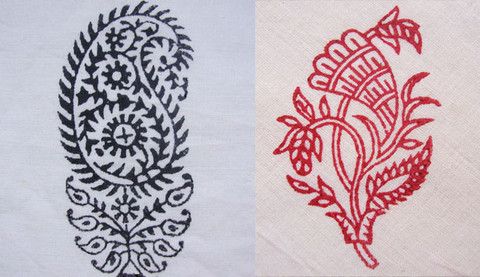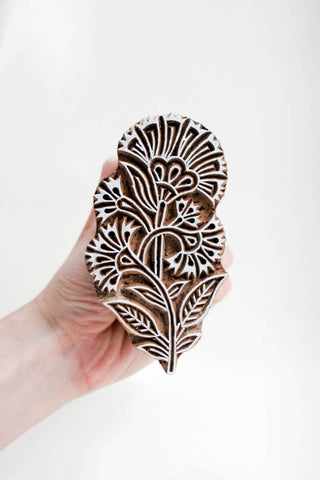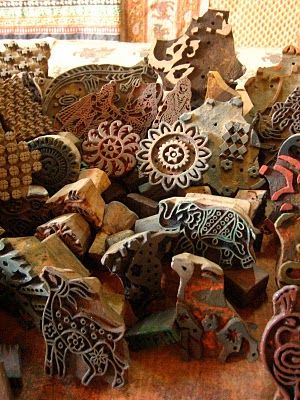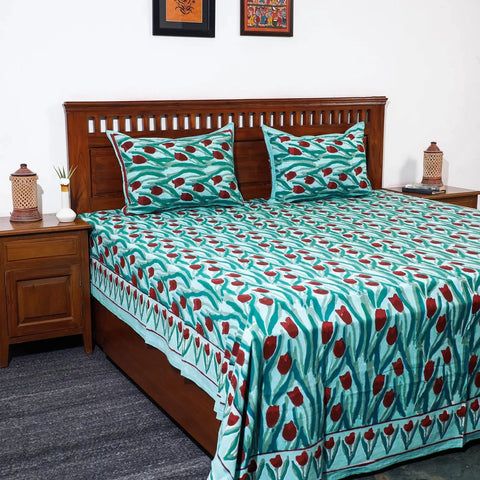Start your journey from the vibrant aura of Pink City to the south for 13-16 km and you will witness a town wrapped in colourful fabric lanes like a painted canvas. This is the Sanganer, a small yet highly renowned town in Rajasthan. The town and its origin history have roots in the 16th century when it was founded by Amber Maharaja's brother Sangaji. The Sanganeri block print is popular due to its delicate print, intricate detailing and fine texture of fabric. But what makes this ancient art so popular even in today’s world? To answer that, we will explore this heritage from history to the face behind it.

Image Credit - Pinterest
Origin And History Of Sanganeri Print
The block printing origin traces back to the late 16th century when the war between the Mughals and Marathas was at its peak. This caused several craft workers, particularly the Chippa community to migrate from Gujarat. During the war, they found support from the Jaipur royal family who were seeking an opportunity to convert Jaipur into a trading centre. Thus, they were invited to reside and practise their craft art in Rajasthan and the Chippa community was allocated lands in Sanganer.

Image Credit - Pinterest
Block Print Process
To craft the beauty of Sanganeri print, the Chippa community used various printing techniques but the direct method was mainly used. Under this block printing process, wooden blocks with special carved patterns were dipped into the dyes and placed onto the fabric in a particular series to get an impression.
Apart from handmade work, do you know what makes them so alluring? It's vibrant hues and natural dyes.

Image Credit - Pinterest
Role Of Dye Used
The beauty that Sanganeri print carries is enhanced by the dyes used in printing. These colourful dyes are extracted from natural elements like flowers, fruits, vegetables and metals. Owing to this, dyes give a smooth and spiritual effect throughout the fabric. It also prevents skin allergies and makes the outfit appear gorgeous. Major dye colours are saffron, yellow, blue and red and for desired colouring a blend of these shades is applied.

Chhipa Community
The word Chippa comes from the Chapaai which literally means printing. Their roots reside in the Sindh or Punjab region. But after migration in Rajasthan, they were majorly founded in Nagpur where they skilled their craft. Another theory claims they are a section of the warrior caste Kshatriyas. Since their origin, they are predominantly occupied in the process of textile dyeing and printing. Presently, they can be found in Rajasthan, Gujarat, and Madhya Pradesh.

Image Credit - Pinterest
Designs And Patterns Used in Sanganeri Block Printing
Sanganeri print comes in plenty of variety which majorly includes flower motifs, folk scenes, fruits etc.
Flower Motifs
The magnificent flower motifs of Sanganeri block printing are inspired by the flora and fauna of Rajasthan. Artists inhale the ideas from the lotus, water lily, narcissus, rose, poppy, sunflower flower etc.
God
Another major motif on Sanganeri printed fabric is God’s figures which are majorly placed on borders with dark shades.
Fruits
Sanganeri prints also include the keri, dhatura, pomegranate, banana, grapes and dates as major motifs in their patterns. In addition to this, bel and betel leaves are also major sources of motif designs.
Folk Scenes
As the Chippa community majorly get their inspiration from the culture of Rajasthan, folk scenes depicting the mythological tales are one of the beautiful motifs of this ancient printing.

Image Credit - Pinterest
Sanganeri Prints Today
With its simple yet fascinating designs, Sanganeri block prints have taken over the fashion world. Sanganeri printed fabric is used in a myriad of products - like Sanganeri Kurtis, Sanganeri sarees, dress materials and more. You can also find them in home decor items like bed covers and curtains.
Traditionally, these prints were found on only kurtis but now it can be witnessed on sarees, bedsheets and western dresses.

Care Of Sanganeri Fabric
Although Sanganeri print fabric does not require special care, a little care enhances its life shell. To preserve its beauty, these tips are a must
- Pre-soaked the fabric before washing it
- Use mild detergent; do not use soap bars or brush
- Cold water for washing is highly advisable
- Wash it separately as colour bleeding is usual
- Drying in the shade extends the life
- Keep a cloth in between when ironing the fabric.
Conclusion
The art of Sanganeri print is a beautiful part of our heritage that has earned immense popularity on a global level. From its origin in the 16th century to the present textile world, it has maintained its charm with its exquisite designs and patterns. To strengthen this ancient art, iTokri.com has curated an exclusive collection of Sanganeri block print fabric featuring dupattas, suits, home decor and other accessories. We have blended modern patterns with authentic art hailing from the village of Sanganer.
FAQ’s
Can we wear Sanganeri Print fabric in summer?
Yes, the Sanganeri print is lightweight and perfectly suitable for beating the heat during summer.
Is this fabric easy to maintain?
It is one of the easy-to-maintain prints. Either wash it manually or with a cold water machine with mild detergent to protect.
Does the print fade or colour bleed with a wash?
Colour bleeding is very common in Sanganeri block printing but with gentle washing and care, you can slow down the process.
 Verified Purchase
Verified Purchase



















































































































































































































Leave a comment (all fields required)